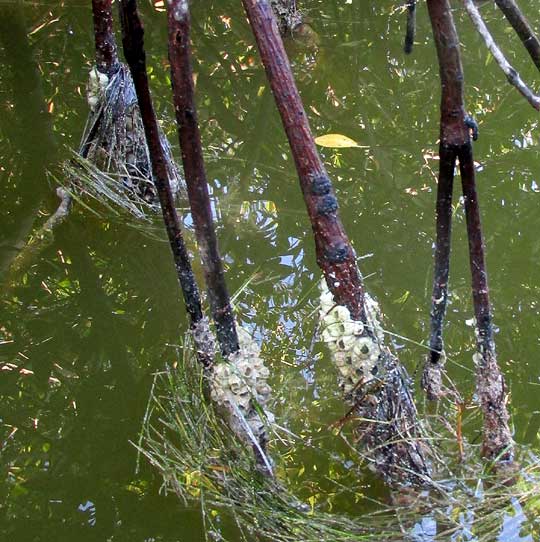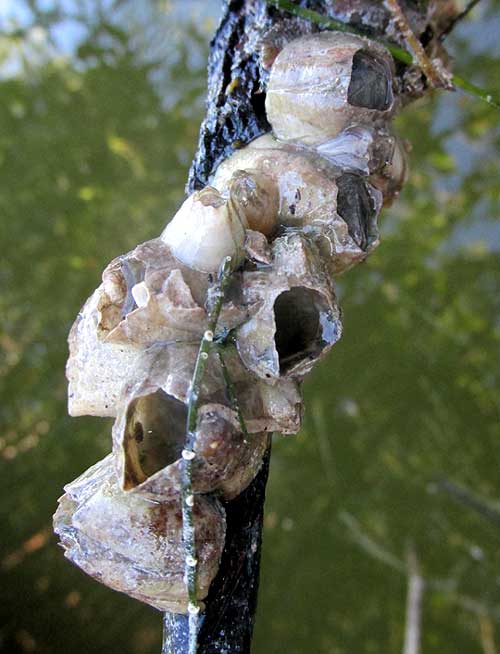Excerpts from Jim Conrad's
Naturalist Newsletter
from the January 4, 2015 Newsletter issued from Río Lagartos, on the Yucatan Peninsula's northern coast (~N21.60°, ~W88.16°), Yucatán state, MÉXICO
IVORY BARNACLE
At low tide along the estuary's shore the Red Mangroves' flaring, branching "stilt roots" are more exposed than at high tide, or even plunge into mud instead of water. You can review what Red Mangroves and their stilt roots look like at www.backyardnature.net/yucatan/mang-red.htm.
At low tide, conspicuous whitish barnacles are seen clustering on many Red Mangrove stilt roots, as shown below:

In that picture, uprooted, floating blades of Shoalgrass catch on the stilt roots as brackish water flows back into the estuary after the lowest water of a low tide. A closer look is below:

Volunteer identifier Bea in Ontario helped me figure out that this probably is the Ivory Barnacle, AMPHIBALANUS EBURNEUS, native to the eastern coast of North America, the Gulf of Mexico and the Caribbean. However, nowadays it's found in tropical and semitropical waters worldwide because it sometimes attaches not only to mangrove roots but also to other hard surfaces such as rocks, mollusk shells, man-made structures like pilings and jetties, and ship hulls, which transport them far away. Sometimes they're transported in ship ballast water. They've become common among Hawaii's main islands and occur along the coast of southern California.
The barnacle organisms live inside the crater-like structure shown in the picture. Those are called mantles and the barnacle organism lives inside them. Each mantle consists of six hard plates made of calcium carbonate, so they're essentially thin slabs of limestone. The barnacle organism lies on its back inside the mantle extending its twelve legs upward through the mantle's opening. The legs bear hair-like "setae," which give the legs a feathery appearance and enable them to filter microscopic plankton from the water, which is then withdrawn into the mantle and eaten.
When disturbed or the tide goes out, the barnacle organism slides movable plates inside the mantle over the opening, closing it until the tide comes back in. In the above picture you can see how the second barnacle from the bottom has its movable plate closed. Some of the mantles appear abandoned. It's common to find empty mantles where the organisms apparently have died or been removed by predators. Barnacles in general are known to be preyed upon by various fishes and invertebrates.
Adult barnacles spend their whole lives inside their mantles, so the question arises as to how they procreate. Ivory Barnacles are hermaphrodites, but cross-fertilization occurs in dense populations. Sex is accomplished when an individual in its male mood extends a tube that might as well be called a penis to outside the crater. The penis is so long that it can grope into adjacent craters seeking receptive female parts.
Fertilized eggs are brooded in the mantle cavity, and it can take several months before larvae are released into the water to become part of the estuary's plankton community, which is so important to the many kinds of filter feeders found there. After a couple of weeks the lavae search out sites for settlement, possibly chemically attracted to already established adults, and maybe testing various surfaces for suitability. Once settled, they cement themselves by their heads to the surface, undergo metamorphosis and become juvenile barnacles, which will now erect their stony mantle around them.
The manner by which the stony mantle grows as the organism inside it metamorphoses into ever larger forms is complex, hard to explain, and apparently not fully understood. An attempt is made in Vernon Harris's 1990 book Sessile Animals of the Sea Shore partly available online through Google Books.